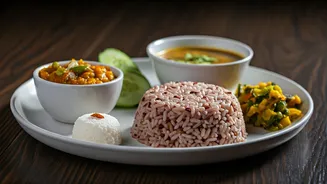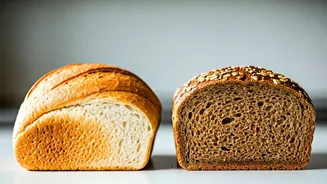Embrace Whole Grains
Switching from refined grains to whole grains is a significant step towards managing diabetes. Refined grains, such as white rice and white flour, are
quickly digested, leading to rapid spikes in blood sugar levels. They lack the fiber that slows down glucose absorption. On the other hand, whole grains like brown rice, oats, quinoa, and millets (like ragi and jowar) contain higher amounts of fiber. This fiber helps regulate blood sugar, promotes better insulin sensitivity, and provides a feeling of fullness, which can assist in weight management. Start by substituting white rice with brown rice or integrating millets into your diet. Using whole-wheat flour instead of all-purpose flour for rotis and parathas is another easy change. Make sure to read labels and opt for whole-grain versions, ensuring that the first ingredient listed is a whole grain. These swaps can drastically enhance the nutritional value of your meals and contribute significantly to blood sugar control. Regular intake of whole grains is associated with a reduced risk of developing type 2 diabetes and a healthier lifestyle overall.
Smart Protein Choices
Selecting protein sources is another crucial area for making diabetes-friendly modifications. Protein plays a key role in slowing down the absorption of carbohydrates, which helps prevent blood sugar spikes after meals. Instead of relying heavily on high-fat, processed meats, opt for lean protein sources. Include options such as lentils (dal), beans (rajma, chole), and lean meats like chicken or fish. Consider incorporating paneer, a good source of protein and calcium, but choose it in moderation, especially if it's prepared with added fats. Avoid heavily processed protein products, such as sausages and pre-marinated meats, which are often high in sodium and unhealthy fats. When preparing your protein, choose healthier cooking methods like grilling, baking, or steaming, rather than deep-frying. For vegetarians, including a variety of dals and beans provides ample protein, fiber, and essential nutrients. Ensure to balance protein intake with vegetables and whole grains for a well-rounded and nutritious meal that supports diabetes management. Portion control is also important, so be mindful of the amount of protein you consume in each meal to stay within recommended daily guidelines.
Healthy Fat Selection
Fats are essential for overall health, but the type of fat consumed can greatly affect blood sugar and overall health. When cooking, swap unhealthy fats for healthy fats to manage diabetes more effectively. Instead of using saturated fats like butter or ghee excessively, switch to unsaturated fats, such as olive oil, canola oil, or avocado oil. These oils can improve heart health and provide a balanced nutritional profile. Limit the use of ghee and butter, which are high in saturated fats that can increase bad cholesterol levels. Include healthy fats in your diet by adding nuts, seeds, and avocados to your meals. A handful of almonds or walnuts as a snack can be a good choice, providing fiber and healthy fats. Additionally, include fatty fish like salmon or mackerel in your diet a couple of times a week, as they are rich in omega-3 fatty acids, which have anti-inflammatory benefits and support heart health. Make a conscious effort to prepare meals that minimize added fats. Avoid deep-frying foods, as this adds unhealthy fats to your diet. Instead, opt for baking, grilling, or sautéing, and carefully control the amount of oil used in these cooking methods. By making these changes, you can ensure that you're consuming the right types and amounts of fats to manage your diabetes.
Prioritize Vegetables & Fruits
Making vegetables and fruits the core of your meals is crucial for diabetes management. These foods are packed with fiber, vitamins, and minerals while being relatively low in calories and carbohydrates. Non-starchy vegetables such as leafy greens, bell peppers, onions, and tomatoes are particularly beneficial, as they have a minimal impact on blood sugar levels. Fill half of your plate with vegetables at each meal to maximize your fiber intake and enhance satiety. When choosing fruits, focus on those with a lower glycemic index (GI), such as berries, apples, and oranges. Be mindful of portion sizes, as even healthy fruits contain natural sugars. Avoid consuming large quantities of fruit juice, as it lacks the fiber found in whole fruits and can lead to rapid blood sugar spikes. Incorporate a variety of colorful fruits and vegetables into your meals to ensure a wide range of nutrients. Consider preparing salads, stir-fries, or vegetable-based curries to make it easier to increase your intake of these essential foods. Planning meals around vegetables allows you to control portion sizes and reduce the consumption of other high-carbohydrate foods. This strategy supports better blood sugar control and contributes to overall health and wellness.
Control Your Sweeteners
Managing sugar intake is paramount when it comes to diabetes. The easiest way to do this is to reduce the amount of added sugars in your meals and beverages. Minimize the use of sugar, honey, and jaggery in your cooking and baking. Instead, explore healthier alternatives that have a lower impact on blood sugar levels. Options like stevia, erythritol, and monk fruit are natural, zero-calorie sweeteners that can be used as alternatives in your diet. However, use these sweeteners in moderation. Be mindful of hidden sugars, such as those found in sweetened beverages, processed foods, and desserts. Always check food labels to understand the sugar content. When preparing Indian sweets, experiment with using less sugar or substituting it with the healthier alternatives. Consider making adjustments to traditional recipes. For example, in a sweet dish, you could use a sugar-free sweetener and reduce the amount of other ingredients like refined flour. This allows you to indulge in your favorite treats while managing your blood sugar levels effectively. Make it a habit to limit your consumption of packaged snacks, which often contain high amounts of added sugar. Focus on naturally sweet foods and unsweetened options to maintain better control over your blood sugar.









